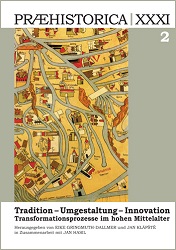Ländliche Siedlungsentwicklung im mittelalterlichen Westfalen
Settlement Development in Medieval Westfalia
Author(s): Rudolf BergmannSubject(s): Social history, Social development, 6th to 12th Centuries, 13th to 14th Centuries
Published by: Univerzita Karlova v Praze, Nakladatelství Karolinum
Keywords: interdisciplinary research; Westfalian landscapes; parish in continental Saxony; medieval settlement of Drubbel type; hamlet; planned linear settlement of Hagenhufen type; interior land colonisation;
Summary/Abstract: Westfalia consists of a wide range of landscapes, varying from lowlands (Muensterland) to low midlands (Weserbergland) and higher midlands (Sauerland). It includes regions with fertile loess soils especially on the lowland’s border (Hellwegboerde). Whereas in the Muensterland isolated farmsteads (in the regions centre) and settlements of the Drubbel type were the most common, in other regions in medieval times, hamlets were most usual. Villages were rare and often the result of an intensive 13th/14th century desertion, which led to settlement concentration (comp. Abb. 1). There is clear evidence, that within the time from about 800 A. D. up to the 10th century there is an explosion of newly founded settlements, most creating hamlets of the -inghusen and -husen type in the South and East of Westfalia as well as within the Hellwegboerde. Interior land colonisation started with early forms of planned settlement on heavy clay soils of the central Muensterland within the 11th century (see Abb. 4). There is only one region within eastern Westfalia (country Lippe) that was heavily settled up by Hagenhufensiedlungen, representing a type of developed planned linear settlement. Material collected from deserted farmsteads within existing settlements of the Hagenhufen type indicates that in the county Lippe they were founded before grey earthenware came into general use (which is approximately before 1170/80 A. D.). As can be seen from the small number of totally deserted settlements of Hagenhufen type in the far South-East of Westfalia, the foundation of them must have been still in progress around 1300 A. D. Intensive excavation mainly focused on the lowlands region has revealed the existence of two main types of medieval housings (type Teltge and Oelde; see Abb. 2). In addition there is unique proof of a late 12th–14th century type of house, that consisted of one part built in stone (Steinwerk) and a bigger part erected as a timber-framed structure, excavated in towns, hamlets and within a deserted cistercian grange (see Abb. 3). The connecting link of rural society was the parish. The extended old parishes, resulting from the Saxons’ christianisation in the last quarter of the 8th century, were split up later and at the end of the medieval period formed units containing approximately up to 10–12 rural settlements.
Journal: Praehistorica
- Issue Year: 31/2013
- Issue No: 2
- Page Range: 13-41
- Page Count: 29
- Language: German

